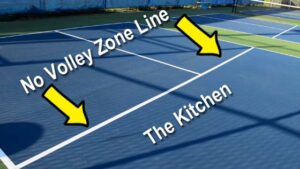The following 3 strategies will help any beginner understand the basic pickleball return of serve strategy.
1. Master your starting position for the best pickleball return of serve strategy.
Return of serve starting position is usually 18 to 24 inches behind the kitchen. This helps you to stay far enough back that you don’t enter the pickleball kitchen before the third hit while keeping you close enough to control where your return of serve will go.
If the wind is pushing the ball toward you, then you may want to adjust your starting position further back on the court, where as if the wind is blowing toward your opponent or your opponent is serving shallow you can adjust forward a bit.
The goal of your starting position is to keep yourself on balance with your weight on the balls of your feet and your body in an athletic position. Your paddle should strike the ball at the apex of the shot.
2. Timing your pickleball return of serve.
Don’t rush your return!
Too often players, especially beginners like me, will rush toward the serve and wind up short hopping the ball or mis-hitting it on the edge of the paddle.
We want to always try to hit the ball at the peak of the arc for more control and power. Also, hitting the ball on the sweetspot of the paddle will make the pickleball serve return easier.
* Note: One of my favorite books for Pickleball Beginners is “How to Play Pickleball“
3. Don’t wait to watch your pickleball return of serve.
The third common mistake pickleball players make on their pickleball serve return is watching the ball after their hit to see where it goes. That little pause will take away your advantage to move forward toward the net.
Since you can’t control where the pickleball ball goes after you hit it just advance forward as soon as you make contact.

No Volley Zone Line and The Kitchen for Pickleball
No Volley Zone Line
The team receiving the serve needs to return the ball and get up to the no volley zone line.
I have found that just being aggressive in your advance to the no volley zone line sometimes will be a destraction for the other team. They are trying to position themselves in a way that will allow them to hit the ball to your feet or somewhere on the court and if you give them the “quiet” time they need to set themselves up you may lose the point.
Attack the no volley zone line after your return of serve. For rules on the no volley zone click here.
If you have been struggling with Pickleball Elbow Pain > click here.
4. Reverse Engineer the Pickleball Return of Serve Strategy
The most common tips pickleball coaches are teaching fro return of serve include:
- Hit to the backhand
- Hit it deep
- Hit it to the weaker player
- Change the tempo
If you already know the pickleball server is going to use these strategies, reverse engineer their service strategy with your return of serve strategy.
If I know they other team is going to serve to my backhand, I want to bias my body closer to the out of bounds position to force a serve to my forehand side (see also ‘How To Hit Forehand‘). I also want to be ready to move my body quickly to the side as soon as the serve is hit to give me room to swing.
If the other team wants to hit a deep serve I will shift my return of serve position deeper in the court. But if the wind is blowing toward me I need to recognize that the serve could be carried out of bounds.
If I can tell what the other team is doing before they do it I will be better positioned to return the serve where I want and how I want.
For more information on the pickleball return of serve strategy watch the following video from Pickleball Kitchen.



